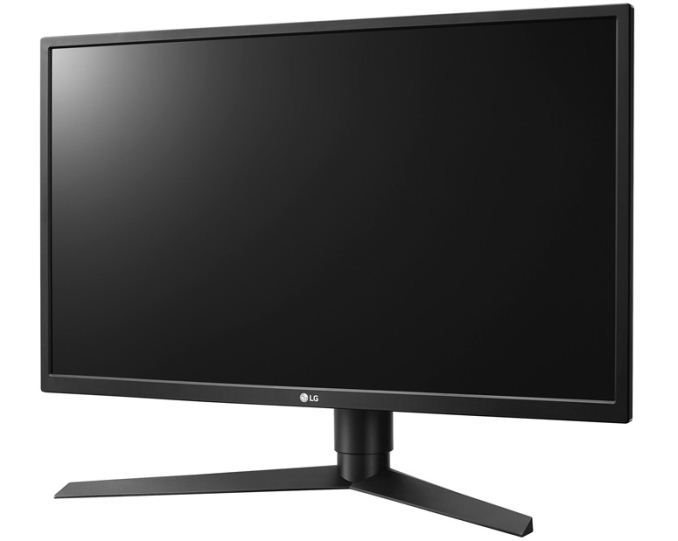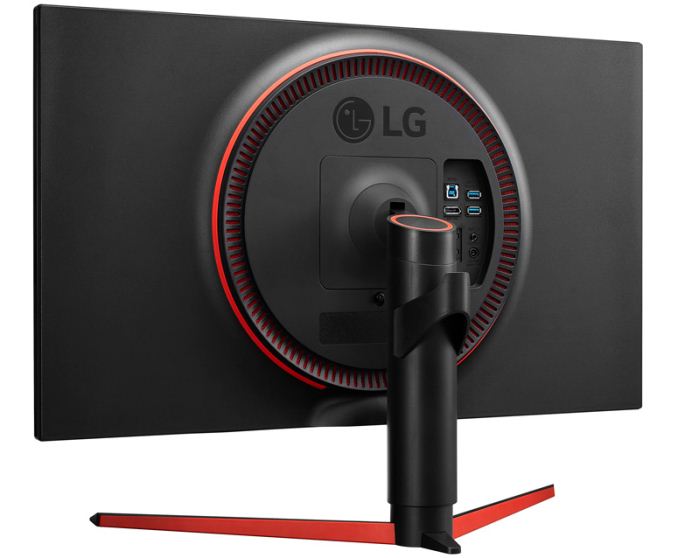Smooth As 240 Hz Butter: LG's 27GK750F-B, a 27-inch eSports Monitor with FreeSync, Launched for $550
by Anton Shilov on December 21, 2017 12:35 PM EST
LG has greatly expanded its lineup of monitors for gamers over the past few years. The company targets mainstream and premium segments of the market, but this month it decided to offer something for “eSports” gamers who demand maximum refresh rates and the lowest possible response time to hit their enemies first. In addition to the rather extreme peak refresh rate, the monitor also supports LG’s Motion Blur Reduction technology to make fast-paced actions look sharper.
The LG 27GK750F-B is outfitted with a 27” TN panel with an FHD (1920×1080) resolution that has a refresh rate of up to 240 Hz as well as a 3H antiglare coating. The panel can display 16.7 million (8-bit) colors, has a 400 cd/m2 typical brightness (a bit higher compared to average monitors), and features 170°/160° viewing angles (which is typical of TN technology). LG claims that the native GtG response time of the panel is 2 ms, but it “shrinks” to 1 ms once backlight strobing is activated. LG calls this feature Motion Blur Reduction (MBR) and it looks like it works the same way as NVIDIA’s ULMB — by inserting a black frame after each normal one. LG’s MBR does not work with AMD’s FreeSync and naturally lowers luminance, but when you need to make things look sharper to shoot your enemies more accurately, this looks like a fair trade-off.
Since the monitor was designed for gamers, it is natural that it comes with various enhancements just for this audience. LG highlights such features as the Black Stabilizer to make dark areas lighter, the Crosshair that always displays target point in the center of the screen, and various modes tailored for FPS and RTS genres.
Moving on to connectivity and ergonomics. The LG 27GK750F-B has one DisplayPort 1.2a as well as two HDMI 2.0 inputs (so, one for a high-end PC, two for game consoles). There is also a dual-port USB 3.0 integrated hub and a 3.5-mm audio jack for headphones. To make the device more comfortable to use, LG equips it with a stand that can adjust height, tilt, swivel and even lets the user have the monitor in portrait mode. The display lacks VESA mounting, although this might not be a problem for eSports players. Furthermore, since many of the latter do not really need additional bling, bells and whistles, LG decided not to equip its 27GK750F-B with customizable RGB LEDs and limited decorations to a minimum — a couple of red inlays here and there.
| LG's 27" Class Full HD Gaming Monitor with FreeSync | ||
| 27GK750F-B | ||
| Panel | 27" TN | |
| Native Resolution | 1920 × 1080 | |
| Refresh Rate | 240 Hz | |
| Dynamic Refresh Rate | AMD FreeSync* *Not available when LG MBR enabled |
|
| Response Time | 2 ms (gray-to-gray) 1 ms with Motion Blur Reduction |
|
| Brightness | 400 cd/m² | |
| Contrast | 'mega' | |
| Viewing Angles | 170°/160° horizontal/vertical | |
| Color Gamut | NTSC: 72% | |
| Inputs | 2 × HDMI 2.0 1 × DisplayPort 1.2a |
|
| USB Hub | Dual-port USB 3.0 hub with Quick Charging | |
| Proprietary Enhancements | Motion Blur Reduction Black Stabilizer Dynamic Action Sync Crosshair Flicker Safe Built-in presets for FPS, RTS games, browsing/reading |
|
| Power Consumption |
Idle | ~0.5 - 0.5 W |
| Active | 30 W | |
| Stand Adjustments | Tilt | -5º to 15º |
| Swivel | -20º to +20º | |
| Height | 110 mm | |
| Pivot | 0º to 90º | |
| Detailed Information | Link | |
| Check Availability | Amazon | |
The LG 27GK750F-B display is listed on the manufacturer’s website and is priced at $549.99. The monitor is currently unavailable from major retailers like Amazon or Newegg, but expect it to hit the shelves in the coming weeks.
Related Reading
- LG’s 34UC89G 21:9 Curved Display with G-Sync, 144 to 166 Hz, Available for $999
- Iiyama Unveils Its First Curved Gaming Display: 31.5-inch, FHD, 144 Hz, FreeSync
- ASUS Ships ROG Strix XG258Q ‘eSports’ LCD: 1080p 240 Hz Display w/FreeSync
- LG 43UD79-B Launched: 42.5-inch 4K IPS with FreeSync
- Pre-Orders for LG’s 32UD99 Display Available: 4K, DCI-P3, HDR10, FreeSync for $999
- LG Announces the 34UC79G: 34-Inch Curved 21:9 Display with 2560 × 1080 Resolution, 144 Hz Refresh Rate for $700
Source: LG


















21 Comments
View All Comments
Sttm - Thursday, December 21, 2017 - link
$550 for 1080p TN Freesync.Okay I get the argument for 240hz, and 1080p so your GPU can hit 240 FPS, and TN for the faster response times... BUT with FREESYNC... C'mon! How many pro gamers or aspiring pro gamers can even get a Vega 64, or want to over a 1080ti.
And at that cost, might as well settle for 165hz 1440p TN from Asus or Acer.
RKCook - Thursday, December 21, 2017 - link
Maybe its simply because monitor manufacturers are tired of paying NVIDIA for their outdated 2013 G-Sync proprietary module when they could otherwise incorporate it into their own hardware design for free.quiksilvr - Thursday, December 21, 2017 - link
Both technologies have their advantages and disadvantages. It isn't just the module that monitor makers have to install, it is an entire quality control process and nVidia has turned down manufacturers from not meeting certain standards. Some examples: all G-Sync panels must have low framerate compensation; all G-Sync panels must be calibrated to the sRGB color gamut, all G-Sync panels need to have "frequency dependent variable overdrive" (prevents ghosting). The proprietary module does add a bit of cost; but it is also following nVidia's stringent standards that make G-Sync monitors so expensive.And AMD knows it. They realized that with FreeSync they were too open with the standard and early monitors suffered because of it. As a result, they tightened their grip and now with FreeSync 2 coming out, low framerate compensation is now a requirement "and AMD certifies displays for low latency and a minimum allowed dynamic color and brightness range that’s twice as vibrant as standard sRGB displays."
I would give PC World's article on the two standards a read. nVidia monitors may be more expensive but they are for more than just the module.
https://www.pcworld.com/article/2974781/displays
somethi - Thursday, December 21, 2017 - link
no uBeaver M. - Friday, December 22, 2017 - link
Do they really? I remember you could buy the G-Sync module separately at the beginning.poohbear - Saturday, December 23, 2017 - link
Wow quicksilvr, thanks for the info and the link to back it up. Never knew Gsync came with such quality control...makes paying the premium more palatable!Hixbot - Wednesday, December 27, 2017 - link
Gsync doesnt insist a SRGB colorspace, Actually Gysnc HDR displays reference the DCI-P3 colorspace.Diji1 - Thursday, December 21, 2017 - link
And here's someone who is clueless about G-sync and Freesync.Chaitanya - Friday, December 22, 2017 - link
How? G-Sync modules costs money and adds quite a lot to BOM compared to Freesync monitors. Also if you look at G-Sync implementation on laptops you will notice the stupid module isn't necessary and Nvidia is just milking its customers out of money.nathanddrews - Thursday, December 21, 2017 - link
Apparently enough of them to justify selling this monitor?